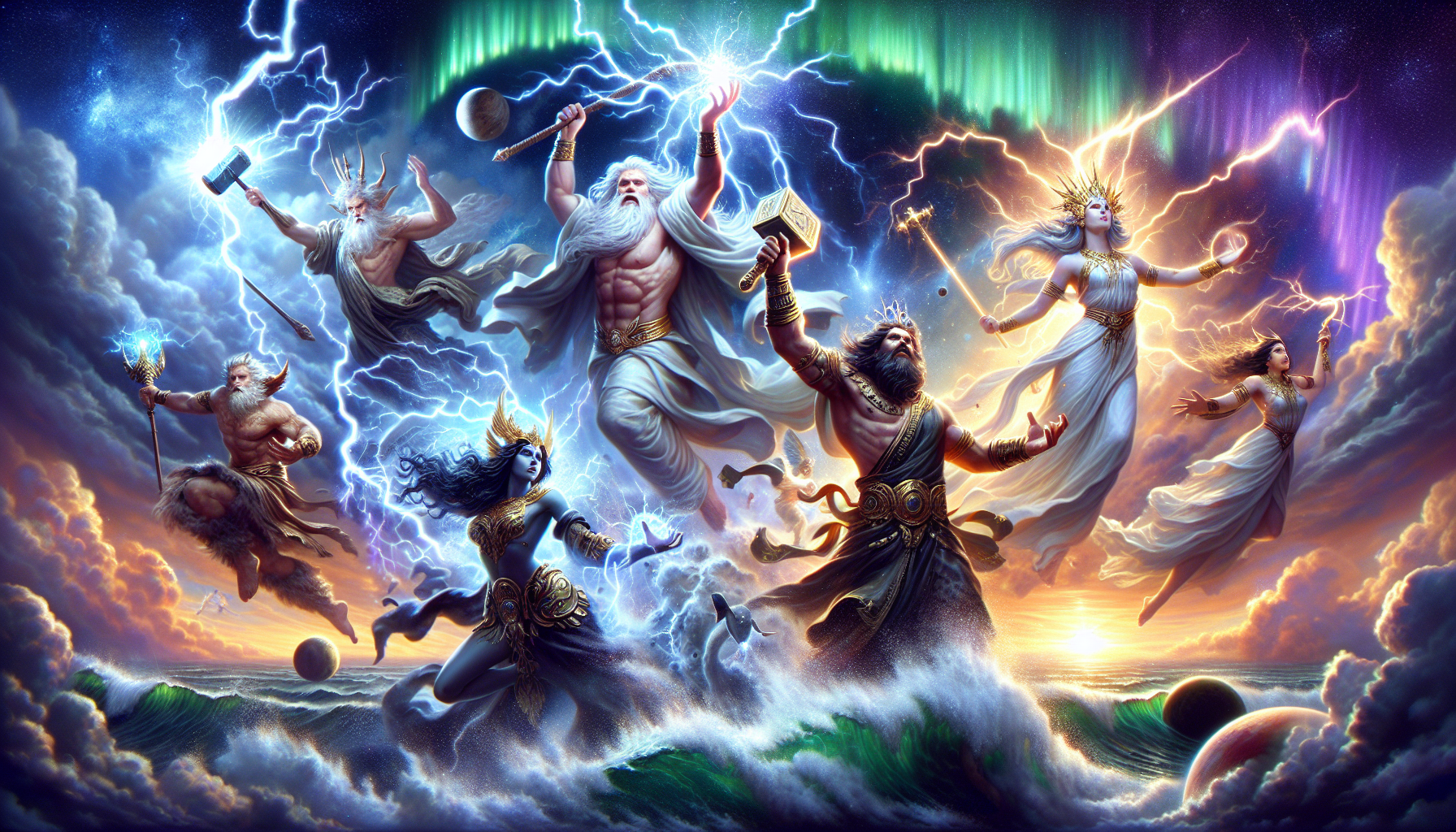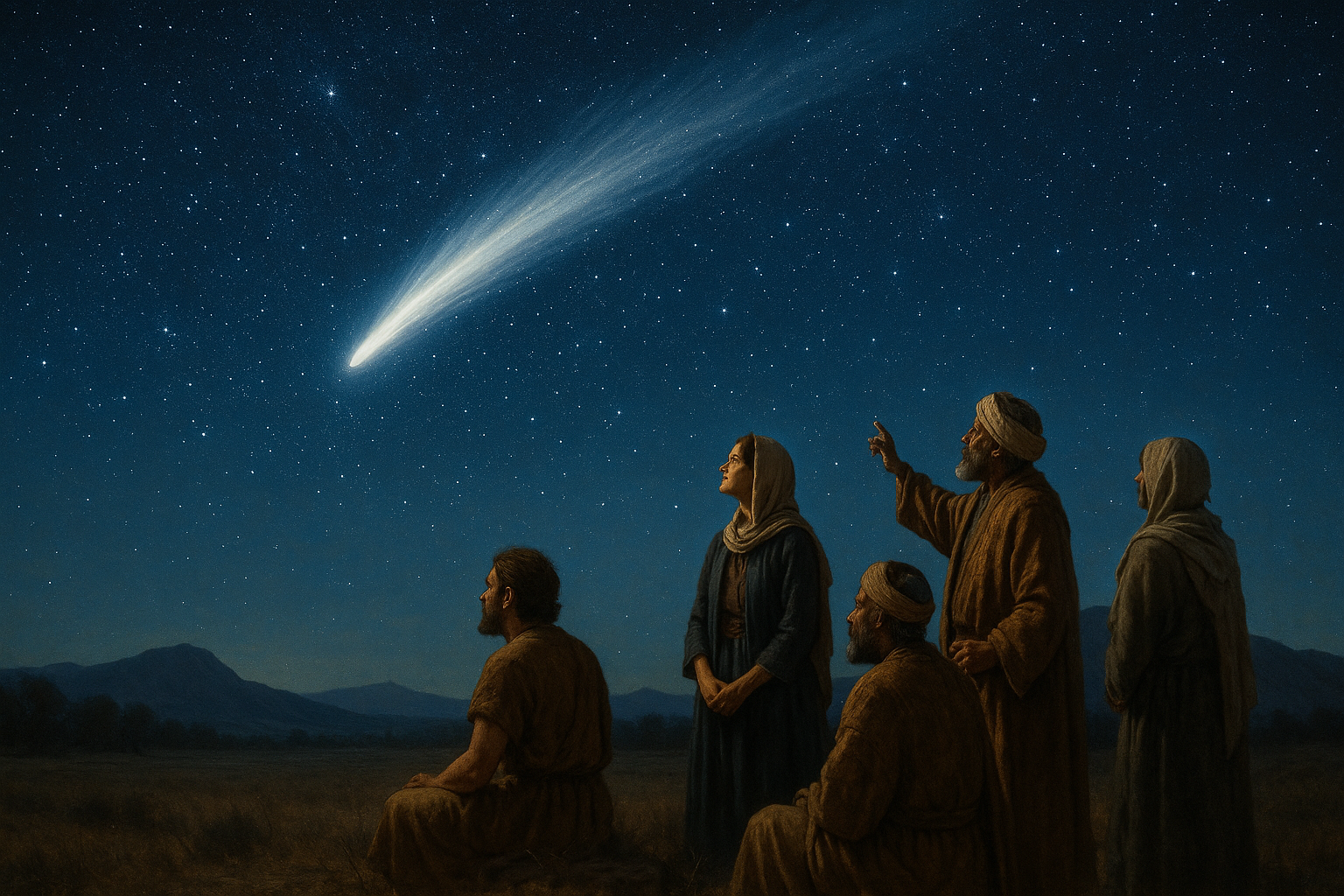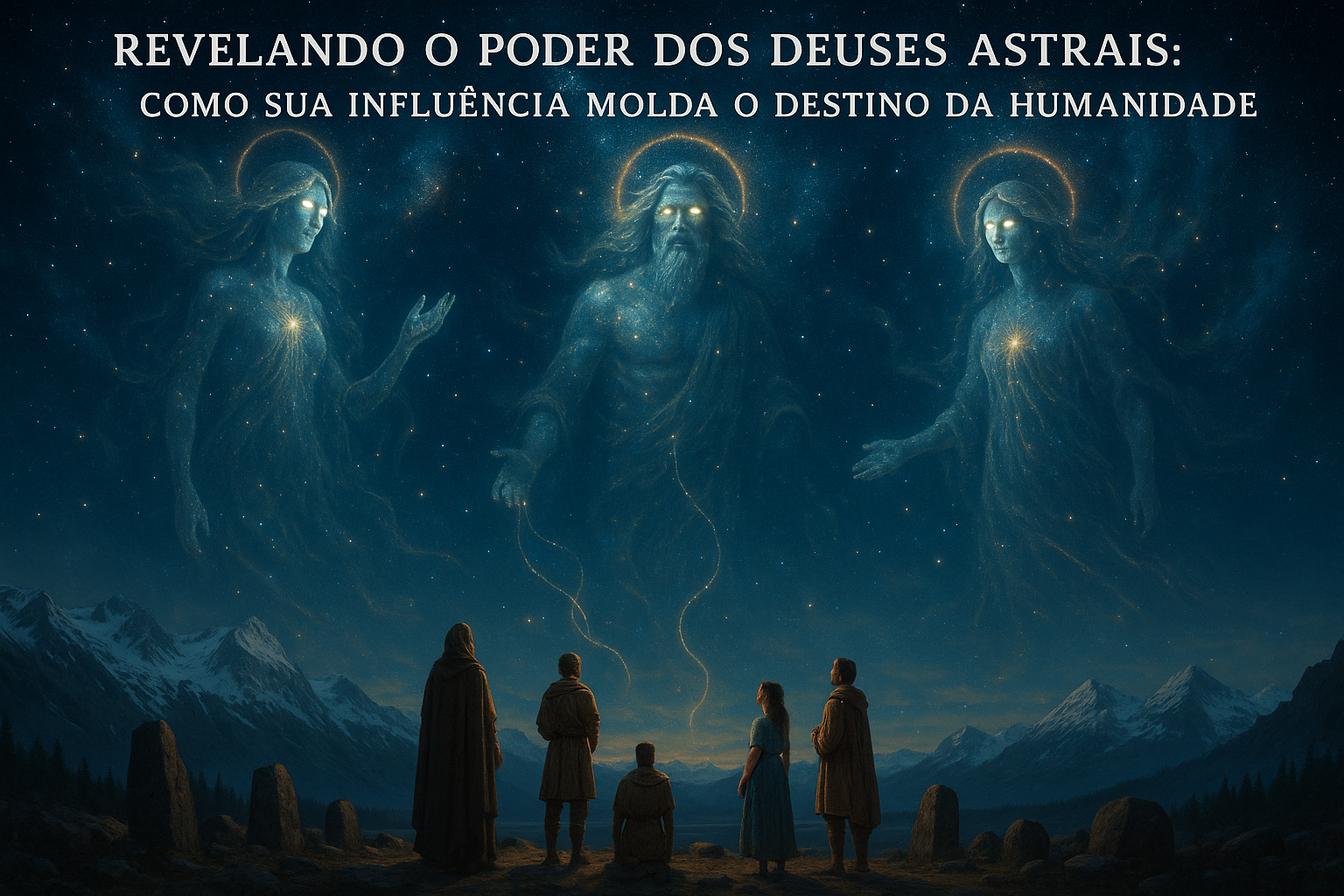In a world where the mysteries of the cosmos have always captured the human imagination, few elements of our universe hold as much wonder and power as the sky. Throughout history, civilizations have gazed upwards, crafting elaborate tales to explain the celestial phenomena that governed their lives. From the rumbling thunder to the dazzling lightning and the vast expanse of stars, the sky has been both a source of fascination and a domain of gods and goddesses who wield unimaginable power. This article embarks on a captivating journey through ancient mythology, unraveling the enigmatic tales of the mighty sky deities who reigned supreme in the heavens above. ⚡
Imagine standing on a hilltop thousands of years ago, your eyes fixed upon the celestial dome. The sky, in its ever-changing hues, served as a canvas for the gods. It was here, among the clouds and constellations, that the ancients found divine entities that governed not only the weather but also the very fate of humankind. These sky gods and goddesses were often portrayed as powerful, unpredictable, and awe-inspiring, reflecting the majesty and mystery of the heavens themselves. As we explore these mythological figures, we will uncover the stories that highlight their might and influence across various cultures and eras.
Our exploration begins with the formidable Zeus, the king of the Greek pantheon, whose dominion over thunder and lightning symbolized his control over the skies. His Roman counterpart, Jupiter, shared similar attributes, casting storms and wielding bolts with unmatched authority. But beyond the familiar Western narratives, the skies are populated with a diverse array of deities from different corners of the world. From the Norse god Thor, renowned for his mighty hammer and tempestuous nature, to the Egyptian goddess Nut, who formed the very canopy of the heavens, these divine figures each bring unique stories and characteristics that highlight the cultural nuances of their respective mythologies.
As we journey further, we will delve into the fascinating roles these deities played in shaping human understanding and interaction with the natural world. The reverence and fear they commanded often influenced societal norms, agricultural practices, and even political structures. These sky gods and goddesses were more than mere myth; they were integral to the identity and survival of the communities that worshiped them. Through rituals, offerings, and elaborate temples, the ancients sought to appease these celestial rulers, ensuring bountiful harvests and protection from calamities.
Prepare to be enchanted by the tales of love, rivalry, and adventure that define these celestial beings. Discover how their stories echo through time, leaving a legacy that continues to influence literature, art, and popular culture today. Whether it’s the epic battles fought in the skies or the tender bonds between divine and mortal, the narratives of these sky deities offer timeless lessons and insights into the human condition. So, look up and let your imagination soar as we unveil the mighty sky gods and goddesses of ancient mythology—a testament to humanity’s enduring fascination with the heavens. 🌌
Introduction to the Sky Gods and Goddesses
The vast expanse of the sky has always been a source of wonder and inspiration for humanity. Throughout history, different cultures have gazed upwards and attributed divine significance to the heavens, leading to the creation of powerful sky deities. These gods and goddesses, ruling over the elements and celestial bodies, played pivotal roles in ancient mythologies, influencing everything from weather patterns to the fate of mortals.
Sky deities were often seen as the ultimate authority figures, governing the universe from their lofty realms. They represented the connection between the earth and the cosmos, embodying both creation and destruction. Their stories are rich with symbolism and lessons that echo through the ages, revealing much about the societies that worshipped them.
In this article, we delve into the fascinating world of these mighty sky gods and goddesses, exploring their characteristics, domains, and the cultural contexts that shaped their legends. Join us on this journey as we uncover the timeless allure of these celestial beings.
The Power of Zeus: King of the Greek Pantheon
Zeus, the thunderbolt-wielding king of the Greek pantheon, is perhaps one of the most well-known sky gods in mythology. As the ruler of Mount Olympus, he was regarded as the god of the sky, lightning, and thunder. His influence extended beyond mere weather phenomena; he was also the enforcer of justice and the protector of order among gods and mortals alike.
According to Greek mythology, Zeus was the son of the Titans Cronus and Rhea. To prevent a prophecy that one of his children would overthrow him, Cronus swallowed each of his offspring at birth. However, Zeus escaped this fate and eventually led a revolt against Cronus, freeing his siblings and establishing himself as the supreme deity.
Zeus’s reign was characterized by his numerous affairs with goddesses and mortals, resulting in a vast lineage of divine and heroic offspring. Despite his sometimes capricious nature, he was often invoked by Greeks seeking protection or favor. His ability to control the weather, particularly thunder and lightning, reinforced his image as a powerful and fearsome god.
For a deeper understanding of Zeus’s role in Greek mythology, check out the video below:
“The Power of Zeus” – Mythology Explained
The Egyptian Sky Goddess Nut
In ancient Egyptian mythology, Nut was the goddess of the sky, depicted as a woman arching over the earth, her body adorned with stars. She was considered the barrier separating the chaos of the cosmos from the ordered world of the living. Her role was essential in maintaining the balance of the universe, as she swallowed the sun each evening and gave birth to it each morning, symbolizing the cycle of day and night.
Nut was one of the Ennead of Heliopolis, a group of nine deities who played a central role in Egyptian creation myths. She was married to Geb, the earth god, and their union produced some of the most important gods in the Egyptian pantheon, including Osiris, Isis, Set, and Nephthys.
The worship of Nut was closely linked to the ancient Egyptians’ understanding of astronomy and their reverence for the afterlife. Her image was often depicted on the ceilings of tombs, providing protection to the deceased as they journeyed to the afterlife. Nut’s story reflects the Egyptian belief in the interconnectedness of the natural and spiritual worlds.
For more insights into Nut and her significance in Egyptian mythology, watch this video:
“Egyptian Goddess Nut: Keeper of the Sky” – History Uncovered
Thor: The Norse God of Thunder
Thor, the Norse god of thunder, was a formidable figure in Viking mythology. Known for his immense strength and bravery, he was the protector of mankind and the gods’ realm, Asgard. Armed with his enchanted hammer, Mjölnir, Thor was able to control storms, protect against giants, and ensure the safety of the cosmos.
In the rich tapestry of Norse mythology, Thor was the son of Odin, the Allfather, and Jord, the personification of the Earth. His exploits were legendary, often involving battles against giants and other monstrous creatures that threatened the world. Despite his fearsome reputation, Thor was also a figure of great honor and justice, respected by gods and mortals alike.
Thor’s stories have endured through the ages, serving as a testament to the Norse people’s values and their understanding of the natural world. His role as a sky deity who wielded control over thunder and lightning is emblematic of the awe and respect the ancient Norse had for the raw power of nature.
To explore Thor’s mythology further, check out the following video:
“Thor: The God of Thunder” – Norse Mythology Channel
Comparing Sky Deities Across Cultures
While each culture’s depiction of sky deities is unique, there are intriguing similarities in how these gods and goddesses are characterized and revered. Many share attributes of control over weather, justice, and the maintenance of cosmic order, highlighting the universal human fascination with the sky and its mysteries.
Below is a comparative table highlighting key attributes of various sky gods and goddesses:
| Deity | Civilization | Attributes | Symbolism |
|---|---|---|---|
| Zeus | Greek | Lightning, Thunder, Justice | Supreme Authority, Order |
| Nut | Egyptian | Sky, Stars, Cosmic Balance | Protection, Cycle of Life |
| Thor | Norse | Thunder, Storms, Protection | Strength, Honor |
As you examine the table, consider how these deities reflect the cultural priorities and environmental realities of their respective civilizations. It’s a fascinating glimpse into the human psyche and our enduring quest to make sense of the universe.
Hindu Sky God: Indra
In Hindu mythology, Indra is the king of the gods and the god of rain and thunderstorms. Known for his powerful Vajra (thunderbolt), Indra played a crucial role in the Rigvedic texts as a warrior deity who vanquished demons and protected humanity. His stories often emphasize themes of valor, sacrifice, and the restoration of cosmic order.
Indra’s character is multifaceted; he is both revered and criticized within the vast Hindu pantheon. While celebrated for his prowess and victories, he is also depicted as a deity with human-like flaws, such as pride and indulgence. These narratives serve as moral lessons about the dangers of excess and the importance of humility.
Indra’s connection to the sky and weather made him a central figure in agricultural societies that depended on monsoons for survival. Rituals and prayers dedicated to Indra sought to ensure bountiful rains and avert natural disasters, reflecting the deity’s vital role in sustaining life.
For an engaging exploration of Indra’s myths, watch this video:
“Indra: King of the Gods” – Indian Mythology Channel
The Role of Sky Deities in Shaping Human Culture
Sky gods and goddesses have not only shaped religious beliefs but have also influenced cultural practices, art, and literature throughout history. Their stories provided frameworks for understanding natural phenomena and guided ethical conduct within societies. In many cases, these deities were invoked in rituals to ensure prosperity, justice, and protection from harm.
The legacy of sky deities can be seen in the enduring symbols and motifs found in modern culture. From literature to film, the archetype of the powerful sky god continues to captivate audiences, reflecting humanity’s ongoing fascination with the mysteries of the cosmos.
As we explore these ancient myths, we gain insights into the values and priorities of past civilizations. These stories remind us of our shared heritage and the timeless quest to comprehend our place in the universe.
To dive deeper into how sky deities influenced human culture, check out this video:
“The Influence of Mythology on Modern Culture” – Mythology Unveiled
Conclusion

Conclusion: Unleashing the Power of the Sky: Exploring the Mighty Sky Gods and Goddesses of Ancient Mythology
Throughout this exploration of ancient mythology, we have traversed the heavens, diving into the fascinating tales of the mighty sky gods and goddesses. These celestial beings, revered across various cultures, hold profound significance and have left an indelible mark on human history and thought. Our journey through the myths of different civilizations has illuminated how these deities personified the sky’s vastness, its mysteries, and its dominion over life on Earth.
We began by examining the prominent role these sky deities played in ancient societies, serving as symbols of power, authority, and transcendence. From the thunderous might of Zeus in Greek mythology to the all-seeing eye of Ra in Egyptian lore, each culture imbued their sky god or goddess with traits that reflected their understanding of the world and the cosmos. The sky, with its endless expanse, has always been a source of wonder and inspiration, representing the unreachable and the divine.
A key point highlighted in our discussion was the duality often present in these deities. They embody both creation and destruction, providing life-giving rains and devastating storms. This dual nature symbolizes the balance of life itself, a concept that ancient peoples understood intuitively and represented through their divine figures. These stories remind us of the fragile equilibrium that sustains our world and the respect our ancestors held for the forces of nature.
We also delved into the rich narratives that surround these deities, understanding how myths served not only as entertainment but also as vehicles for cultural values, moral lessons, and social order. The tales of the sky gods and goddesses often depicted themes of power struggles, morality, and the human condition, mirroring the complexities of human society. By exploring these myths, we gain insight into the human psyche and the perennial quest for understanding our place in the universe.
Moreover, our exploration shed light on the interconnectedness of these myths across different cultures. Despite geographical and temporal distances, similarities in the portrayal of sky deities reveal a shared human experience and a universal search for meaning. This common thread underscores the importance of mythology as a bridge between cultures, offering a unique perspective on the human experience and fostering a sense of unity amidst diversity.
In reinforcing the importance of this theme, it becomes evident that understanding these ancient myths is not merely an academic exercise. These stories continue to influence modern culture, inspiring art, literature, and even contemporary spirituality. They serve as a testament to the enduring power of storytelling and the human need to connect with something greater than ourselves. By engaging with these myths, we tap into a reservoir of wisdom that can inform our lives and guide our interactions with the world.
As we conclude this exploration of the mighty sky gods and goddesses, I invite you, dear reader, to reflect on the lessons these ancient myths offer. Consider how the themes of power, balance, and transcendence resonate with you and how they might be applied in your own life. Whether through personal reflection, creative expression, or scholarly pursuit, there is much to be gained from engaging with these timeless stories.
Furthermore, I encourage you to share your thoughts and insights with others. Engage in discussions, share this article with friends and family, and explore further into the rich tapestry of world mythology. By doing so, you contribute to the ongoing dialogue about our shared human heritage and help keep these ancient stories alive for future generations.
In closing, let us remember that the sky, with its boundless mysteries and infinite possibilities, continues to inspire and challenge us. The stories of the sky gods and goddesses remind us of our connection to the cosmos and the timeless quest for understanding. May we all draw inspiration from these myths and continue to explore the skies, both within and beyond, with curiosity and reverence. 🌌
For further reading and exploration into the mythology of sky deities, you may visit the following resources:
– Encyclopedia Mythica – Sky Deities (Please verify the link for the most current information)
– Theoi Greek Mythology – Zeus
– Ancient Egypt Online – Ra
**References**
– Burkert, Walter. *Greek Religion*. Harvard University Press.
– Wilkinson, Richard H. *The Complete Gods and Goddesses of Ancient Egypt*. Thames & Hudson.
Toni Santos is a visual storyteller and cosmic interpreter whose work illuminates the ancient skywatchers and their prehistoric astronomy—the profound ways early humans observed and revered the heavens before written history. Through a visionary lens, Toni explores how the stars, planets, and celestial cycles shaped myth, ritual, and survival in cultures lost to time.
Rooted in a fascination with archaic observatories, stone alignments, and celestial symbolism, Toni’s creative journey reveals the deep human impulse to understand and harmonize with the cosmos. From lunar phases guiding planting seasons to the sacred paths of the Milky Way, each of his works embodies the awe and knowledge encoded in the night sky.
Combining artistic craftsmanship with archaeological insight, Toni’s pieces evoke the mystery and precision of prehistoric astronomers. His work does more than depict—it channels the timeless dance between earth and sky, bridging ancient wisdom with contemporary wonder.
As the visionary behind Vizovex, Toni shares curated visuals, essays, and symbolic studies that invite others to reconnect with the cosmic heritage written in stone and starlight. His creations are a call to look upward, to listen to the silent stories told by the stars, and to honor the first astronomers who mapped the heavens with reverence and ingenuity.
His work is a tribute to:
The celestial wisdom of prehistoric peoples
The sacred geometry of ancient observatories
The enduring bond between human culture and the cosmos
Whether you’re a stargazer, a scholar of ancient mysteries, or someone captivated by the universe’s earliest storytellers, Toni welcomes you to journey through a space where the sky is both map and myth—one constellation, one ritual, one revelation at a time.




